• 1st Place (Best of Show) - Northwest Watercolor Society 2019 Waterworks Amplified
• 2nd Place, Watermedia - Cape Cod Art Center, 2019 Bay State Open Exhibition
• Isabelle Wilson Memorial Award - Watercolor Society of Alabama 79th Annual National Exhibition, 2020
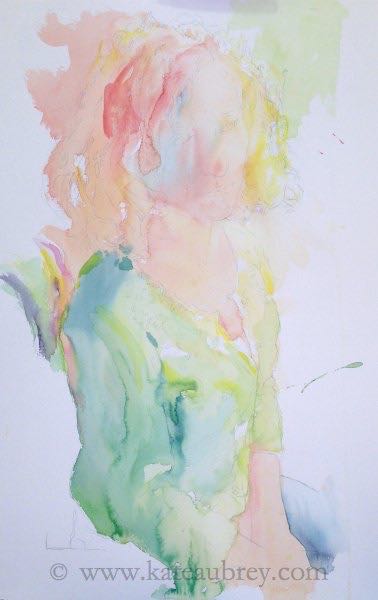
In my portraits and figure work, the first wash is both the most important and the most fun. In a lot of ways, anything goes, which is why white paper doesn’t generally scare me. No matter what I do, what “mistakes” I make, they are all just part of the foundation that allows me to do whatever this painting needs. Drips, runs, spatters, they’re all OK at this point. My colors are all pure hue or very close to pure hue mixes.
I probably don’t need to point it out, but see that streaky little splot on the right side of the painting? It’s definitely not cause to rip up this painting. It looks pretty scary right now, but that’s because there are so few medium and absolutely no dark values on the paper yet. It helps, too, that I have a plan for the background that will pretty much swallow it up if it’s not useful.
Also, it’s important to note that I continue my flesh tones and some greens into the background in such a way that they create some balance within the composition. Even the scary splot balances the painting a bit, planned or not. The sooner you think about composition, the better your painting will be.
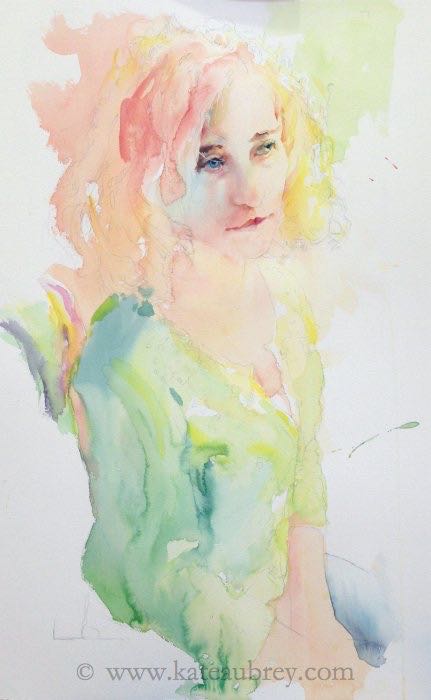
The next thing I pretty much always do is paint in the eyes to as finished a point as possible as soon as the first wash is dry. It’s not because everyone should always do that, but because the eyes seem to be my personal touchstone, the thing against which I compare and measure everything else in my portraits. I have tried painting the mouth or some other feature first, but seem always to lose my way and start doing odd things with my paints that don’t support my vision for the painting.
In this case, I’ve also done some major work on the nose and mouth. Sometimes I go into the background or the hair at this point instead. The decision is kind of a gut one, but I’ve learned over the years to really trust my gut.
You’ll notice the eyes are very different colors. Keep that in mind, just like you’re keeping the stray splash from the first wash in mind….right? Hmmm. It’s not nearly so offensive anymore, is it? Those darks really help.
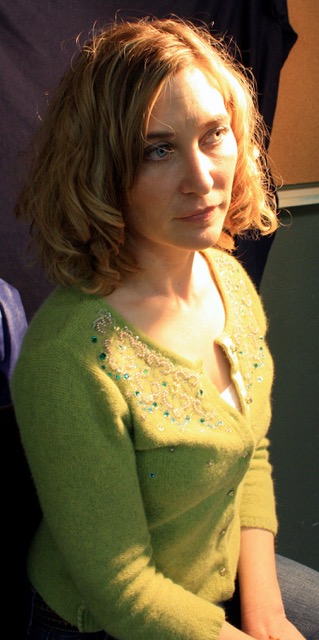
At this point, it was time for me to commit to a compositional structure by working in some of the background darks, then pulling those darks into the main subject. Because I’d painted this model from life several years ago, I already had the structure in mind.
Looking at the photo I took at the time (with the model’s express permission), you can see that the background has some interesting, yet kind of awkward elements. I liked them, but painting them the way they were? Well, let’s just say I didn’t enter the first painting in any competitions. I could never walk away from her though.
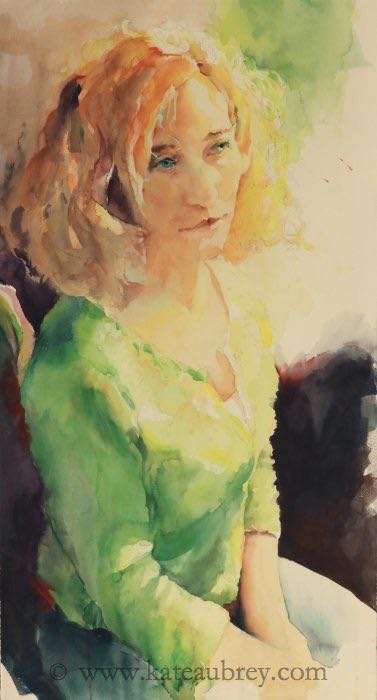
Also, part of the reason she was so compelling was her eye color. They were like crystal, so light a blue that the studio lamp actually turned her lit eye to a light topaz, yet if I’d painted it that way, it would have made people’s skin crawl.
So I rearranged and exaggerated the linear background elements a bit and added a hint of green to her unusual lit eye. At this point, I also adjusted the cropping for the additional visual tension that a narrow vertical format gives.
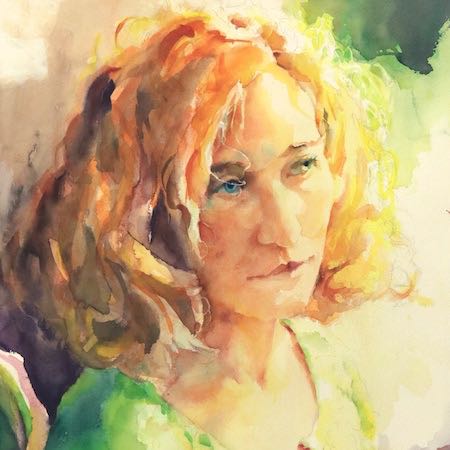
Building depth in the face and hair is an important process of multiple glazes for me. Faster would be nice, but I find I cannot achieve the kind of emotional depth I love when I take the rapid, more simple approach.
So beginning at the point where I have my basic background pretty defined, I start adding darker glazes in the face and neck. To give you an idea of how that works, note that there are additional darks in the upper right detail corner which correspond to and balance with additional dark patterns in her unlit hair.
Then I treated the bright hair along her cheek as part her facial glazing, sticking mainly to glazes of pure hue (cadmiums and pthalo blue) as I painted both the hair shadows that define her cheek and the skin tones around the tendrils of hair catching the light over the shadowed side of her face.
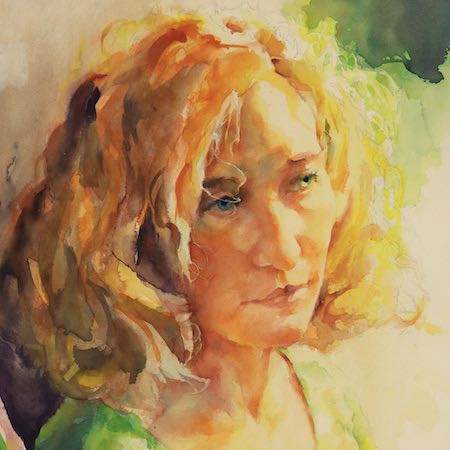
After the previous glaze was completely dry, I repeated the process in the facial and neck shadows, building mainly with my cadmiums, especially cadmium red (due to its darker value), pthalo blue, or a mixture of both.
The danger of mixing the warms with the blue while still building mass in flesh areas is that the skin can easily start looking blotchy, as it does here in her forehead and between her eyebrows. To avoid this, I used straight cadmium red and cadmium red orange on her chin and cheek.
It is important, too, to paint over the shadowed eye in order for the eye socket to recede and the nose to stand out. I glazed over it with my cadmium red so the blue iris would move toward gray as it does in facial shadows. Too much pure blue here would imply sunlight, popping the eye too far forward unless it was applied thickly enough to read as a dark value. Remember, details go away in shadow.
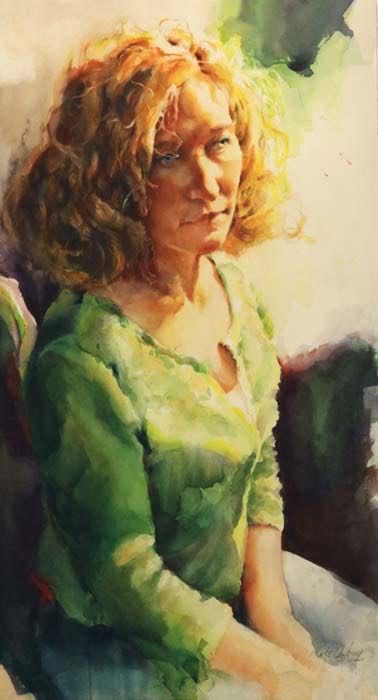
I could have stopped earlier and had a lovely painting, but I would have missed the drama very light lights against very dark darks produce, so I kept laying down mainly cadmium red glazes with some cadmium red light and permanent orange where facial shadows rolled into the light and especially over those bruised-looking blue areas on her forehead.
Only when I had the depth I wanted did I paint over the shadows with a light pthalo blue glaze. This popped the loose hair strands as well as the wonderful mass of her hair forward, and voilá! Drama.
Mother color:
Richeson green (Quiller brand)
Along with:
Cadmium yellow light (Quiller)
Permanent orange (Quiller)
Cadmium red light (Quiller)
Cadmium red (Quiller)
Quinacridone rose (Quiller)
Magenta (M. Graham or Quiller)
Pthalocyanine blue (Quiller)
Richeson turquoise (Quiller)
Ultramarine blue (Quiller)


